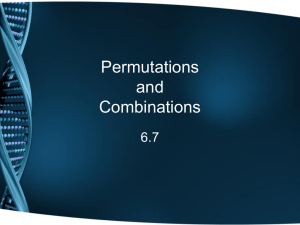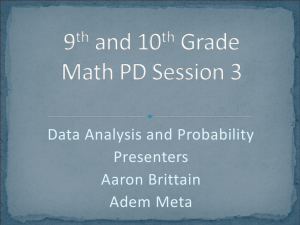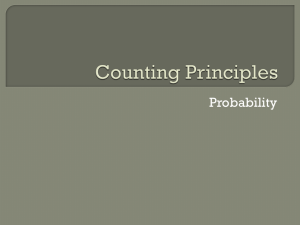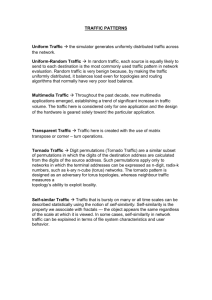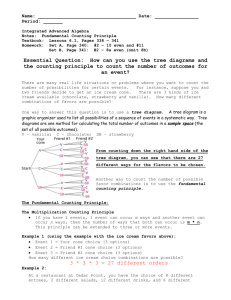S - Uplift Education
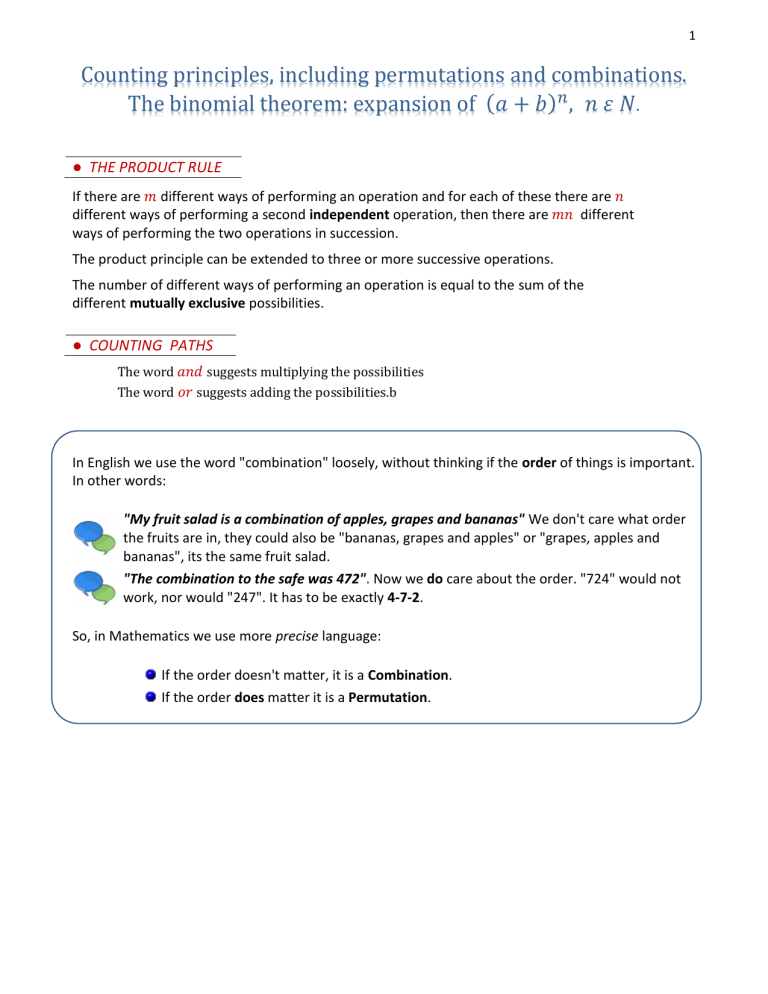
Counting principles, including permutations and combinations.
The binomial theorem: expansion of 𝑎 + 𝑏
𝑛
, 𝑛 𝜀 𝑁
.
1
● THE PRODUCT RULE
If there are 𝑚 different ways of performing an operation and for each of these there are 𝑛 different ways of performing a second independent operation, then there are 𝑚𝑛 different ways of performing the two operations in succession.
The product principle can be extended to three or more successive operations.
The number of different ways of performing an operation is equal to the sum of the different mutually exclusive possibilities.
● COUNTING PATHS
The word 𝑎𝑛𝑑 suggests multiplying the possibilities
The word 𝑜𝑟 suggests adding the possibilities.b
In English we use the word "combination" loosely, without thinking if the order of things is important.
In other words:
"My fruit salad is a combination of apples, grapes and bananas" We don't care what order the fruits are in, they could also be "bananas, grapes and apples" or "grapes, apples and bananas", its the same fruit salad.
"The combination to the safe was 472". Now we do care about the order. "724" would not work, nor would "247". It has to be exactly 4-7-2.
So, in Mathematics we use more precise language:
If the order doesn't matter, it is a Combination.
If the order does matter it is a Permutation.
● PERMUTATIONS
(order matters)
A permutation of a group of symbols is any arrangement of those symbols in a definite order .
● Permutations of
𝒏
different object :
𝒏!
different arrangements
12
21
31
34
34
24
12
21
31
43
43
42
13
23
32
24
14
14
13
23
32
42
41
41
14
24
34
23
13
12
14
24
34
32
31
21
4! = 24
41 23 41 32 42 13 42 31 43 12 43 21
13
23
24
14
13
23
42
41
14
24
23
13
14
24
32
31
31 42 32 41
41 32 42 31
When to use it: Example : There are 6! permutations of the 6 letters of the word square. a) In how many of them is r the second letter? _ r _ _ _ _ b) In how many of them are q and e next to each other?
Solution: a) Let r be the second letter. Then there are 5 ways to fill the first spot. There are 4 ways to
fill the third, 3 to fill the fourth, and so on. There are 5! such permutations. b) Let q and e be one object “qe”. So, there are 5 object and 5! permutations. But q and e
could be together as “eq”. Therefore, the total number of ways they can be next to each
other is 2· 5! = 240.
Wise Advice: If a group of items have to be kept together, treat the items as one object.
Remember that there may be permutations of the items within this group too.
● Permutations of
𝒌
different objects out of
𝑷 𝒏, 𝒌 = 𝑷
𝒌
𝒏
different available
𝒏!
=
𝒏 − 𝒌 !
= 𝒏 𝒏 − 𝟏 𝒏 − 𝟐 𝒏 − 𝒌 + 𝟏
2
Suppose we have 10 letters and want to make groups of 4 letters. For four-letter permutations, there are 10 possibilities for the first letter, 9 for the second, 8 for the third,
3 and 7 for the last letter. We can find the total number of different four-letter permutations by multiplying 10 x 9 x 8 x 7 = 5040. Good logic to apply to similar questions straightforward!!!
To arrive at 10 x 9 x 8 x 7, we need to divide 10! (10 because there are ten objects) by (10-4)!
(subtracting from the total number of objects from which we're choosing the number of objects in each permutation):
𝑃 10,4 =
10
𝑃
4
10!
=
10 − 4 !
=
10 ∙ 9 ∙ 8 ∙ 7 ∙ 6 ∙ 5 ∙ 4 ∙ 3 ∙ 2 ∙ 1
6 ∙ 5 ∙ 4 ∙ 3 ∙ 2 ∙ 1
= 10 ∙ 9 ∙ 8 ∙ 7 = 5040
● Permutations with repetition of
𝒌
different objects out of
𝒏
different available
𝑷𝑹 𝒏, 𝒌 = 𝒏
𝒌
(In other words, there are n possibilities for the first choice, THEN there are n possibilities
for the second choice, and so on, multiplying each time.)
E: For the 3 digits lock combination, there are 10 numbers to choose from (0,1,..9)
and you choose 3 of them (they can be equal!)
10 × 10 × ... (3 times) = 10 3 = 1,000 permutations
● Problems emphasizes differences
Q : How many different 5- digits numbers can be formed with the digits: 1, 2, 3, 4, 5?
S: The order of the elements does matter. The digits cannot be repeated.
There are 5! = 120 𝑓𝑖𝑣𝑒 𝑑𝑖𝑔𝑖𝑡 𝑛𝑢𝑚𝑏𝑒𝑟𝑠 𝑤𝑖𝑡ℎ 𝒅𝒊𝒇𝒇𝒆𝒓𝒆𝒏𝒕 𝑑𝑖𝑔𝑖𝑡𝑠 𝑜𝑢𝑡 𝑜𝑓 1, 2, 3, 4, 5
Q: How many three digit numbers can be formed with the digits: 1, 2, 3, 4, 5?
n = 5 k = 3
S: The order of elements does matter. Elements are repeated.
𝑃𝑅 5,3 = 5 3 = 125
I do it this way:
First place has 5 possibilities, second place 5 possibilities, third place 5 possibilities:
There are 5 ∙ 5 ∙ 5 = 5 3 = 125 𝑡ℎ𝑟𝑒𝑒 𝑑𝑖𝑔𝑖𝑡 𝑛𝑢𝑚𝑏𝑒𝑟𝑠 𝑤𝑖𝑡ℎ 𝑑𝑖𝑔𝑖𝑡𝑠 1, 2, 3, 4, 5
Q : How many different three-digit numbers can be formed with the digits: 1, 2, 3, 4, 5?
S: The order of the elements does matter. The different numbers are 123, 231, 321...
The elements cannot be repeated as the problem states that the figures are different.
5 𝑃
3
5!
=
5 − 3 !
= 5 ∙ 4 ∙ 3 = 60
I do it this way:
First place has 5 possibilities, second place 4 possibilities, third place 3 possibilities:
There are 5 ∙ 4 ∙ 3 = 60 𝑡ℎ𝑟𝑒𝑒 𝑑𝑖𝑔𝑖𝑡 𝑛𝑢𝑚𝑏𝑒𝑟𝑠 𝑤𝑖𝑡ℎ 𝒅𝒊𝒇𝒇𝒆𝒓𝒆𝒏𝒕 𝑑𝑖𝑔𝑖𝑡𝑠 𝑜𝑢𝑡 𝑜𝑓 1, 2, 3, 4, 5
Q: How many three digit numbers can be formed with the digits: 0, 1, 2, 3, 4, 5?
n = 6 k = 3
S : The numbers must be separated into two blocks:
The first set, of one number, can occupy only one of 5 digits because a number does not
begin with zero (except for license plates and other special cases).
n = 5 k = 1
The second block, of two numbers can occupy any digit:
n = 6 k = 2
𝑃 5,1 ∙ 𝑃𝑅 6,2 = 5 ∙ 6 2 = 180
4
I do it this way:
number does not begin with zero
First place has 5 possibilities, second place 6 possibilities, third place 6 possibilities:
There are 5 ∙ 6 2 = 180 𝑡ℎ𝑟𝑒𝑒 𝑑𝑖𝑔𝑖𝑡 𝑛𝑢𝑚𝑏𝑒𝑟𝑠 𝑤𝑖𝑡ℎ 𝑑𝑖𝑔𝑖𝑡𝑠 0, 1, 2, 3, 4, 5
Q:
How many different three digit numbers can be formed with the digits: 0, 1, 2, 3, 4, 5?
n = 6 k = 3
S : The numbers must be separated into two blocks:
The first set, of one number, can occupy only one of 5 digits because a number does not
begin with zero (except for license plates and other special cases).
n = 5 k = 1
The second block, of two numbers, can occupy any two different digits but zero.
𝑃 5,1 ∙ 𝑃 5,2 = 5 ∙ 5 ∙ 4 = 100
I do it this way:
number does not begin with zero
First place has 5 possibilities, second place 5 possibilities, third place 4 possibilities:
There are 5 ∙ 5 ∙ 4 = 100 𝑡ℎ𝑟𝑒𝑒 𝑑𝑖𝑔𝑖𝑡 𝑛𝑢𝑚𝑏𝑒𝑟𝑠 𝑤𝑖𝑡ℎ 𝒅𝒊𝒇𝒇𝒆𝒓𝒆𝒏𝒕 𝑑𝑖𝑔𝑖𝑡𝑠 0, 1, 2, 3, 4, 5
Q:
10 candidates have been presented with awards for their novels in literary contest.
The honor roll (list of cadidates) is formed by the winner, finalist and runners-up.
How many different honor rolls can be formed?
S: n = 10 k = 3
The order of the elements does matter as each honor roll cannot have the same winner
and finalist.
Also, there are no repeated elements as it is assumed that each candidate has entered only
one novel into the contest.
𝑃 10,3 = 10 ∙ 9 ∙ 8 = 720
I do it this way:
First place has 10 possibilities, second place 9 possibilities, third place 8 possibilities:
There are 10 ∙ 9 ∙ 8 = 720 𝒅𝒊𝒇𝒇𝒆𝒓𝒆𝒏𝒕 ℎ𝑜𝑛𝑜𝑟 𝑟𝑜𝑙𝑙𝑠
● COMBINATIONS
(order doesn’t matters)
It is the number of ways of choosing 𝒌 objects out of 𝒏 available given that
▪ The order of the elements does not matter.
5
▪ The elements are not repeated [such as lottery numbers (2,14,15,27,30,33)]
▪ Repetition is Allowed: such as coins in your pocket (5,5,5,10,10) NOT in IB syllabus
The easiest way to explain it is to: assume that the order does matter (ie permutations), then alter it so the order does not matter.
Since the combination does not take into account the order, we have to divide the permutation of the total number of symbols available by the number of redundant possibilities. Since we are choosing a particular number of objects 𝒌 , these objects have a number of redundancies equal to the permutation of the objects (since order doesn’t matter).
However, we also need to divide the permutation n! by the permutation of the objects that are not selected, that is to say 𝒏 − 𝒌 . 𝒏!
𝒌!
𝒏 − 𝒌 !
= 𝒏!
𝒌! 𝒏 − 𝒌 !
𝒏
𝑪 𝒌
≡ 𝑪 𝒏 𝒌 𝒌
= ( 𝒏 𝒌
) = 𝒏!
𝒌! 𝒏 − 𝒌 !
= 𝒏 𝒏 − 𝟏 𝒏 − 𝟐 𝒏 − 𝒌 + 𝟏 𝒌!
Binomial coefficient ( 𝒏 𝒌
) often read as "n choose k"
Difference between permutations and combinations:
For example, let us say balls 1, 2 and 3 were chosen. These are the possibilites:
Order doesn't matter Order does matter
1 2 3
1 3 2
2 1 3
2 3 1
3 1 2
3 2 1
1 2 3
So, the permutations will have 6 times as many possibilities.
● Problem Types given three fruits, an apple, an orange and a pear, there are three combinations of two that can be drawn from this set: an apple and a pear; an apple and an orange; or a pear and an orange.
The order of the elements does not matter.
The elements cannot be repeated.
Q:
In how many ways can a group of five players on the varsity boys basketball team be chosen
from a team of 14 players?
S:
This represents a combination of 14 objects taken 5 at a time and is equal to 2,002.
(
14
5
) =
14!
5! 9!
=
14 ∙ 13 ∙ 12 ∙ 11 ∙ 10
5!
= 2002
Q: On an English exam, students are required to answer four essay questions from a list of nine
questions. How many possible combinations of four questions will there be?
S:
(
9
4
) =
9!
4! 5!
=
9 ∙ 8 ∙ 7 ∙ 6
4!
= 126
● BINOMIAL EXPANSION/THEOREM
𝑎 + 𝑏 𝑛 𝑛
= ∑ ( 𝑛 𝑘
) 𝑎 𝑘=0 𝑛−𝑘 𝑏 𝑘 = 𝑎 𝑛 + ( 𝑛
1
) 𝑎 𝑛−1 𝑏 + ⋯ + ( 𝑛 𝑘
) 𝑎 𝑛−𝑘 𝑏 𝑘 + ⋯ + 𝑏 𝑛 𝑛 𝜀 𝑁 ( 𝑛
0
) ≡ 1 0! ≡ 1
● Binomial Coefficient
( 𝑛 𝑘
) is the coefficient of the term containing 𝑎 𝑛−𝑘
( 𝑛 𝑘
) = 𝑛 𝑛 − 1 𝑛 − 2 ⋯ 𝑛 − 𝑘 + 1 𝑘!
= 𝑛!
𝑘! 𝑛 − 𝑘 !
𝑏 𝑘 in the expansion of 𝑎 + 𝑏 𝑛
= 𝑛!
𝑛 − 𝑘 ! 𝑘!
= ( 𝑛 𝑛 − 𝑘
)
𝑇ℎ𝑒 𝑔𝑒𝑛𝑒𝑟𝑎𝑙 𝑡𝑒𝑟𝑚 𝑜𝑟 𝑘 + 1 𝑡ℎ 𝑡𝑒𝑟𝑚 𝑖𝑠: 𝑇 𝑘+1
= ( 𝑛 𝑘
) 𝑎 𝑛−𝑘 𝑏 𝑘
The constant term is the term containing no variables.
When finding the coefficient of 𝑥 𝑛 always consider the set of all terms containing 𝑥 𝑛
Pascal's Triangle was known long before
Blaise Pascal wrote about it.
It was known to both Chinese and the Arabs , but it seems that Pascal was the first to discover the importance of all of the patterns it contained.
6
7
8

